WILLIAMS COUNTY, Ohio — Amanda Harper, 42, was born was a series of congenital heart defects.
CHD is the most common birth defect, affecting nearly one in 100 newborns, according to the Centers for Disease Control. Harper's case is more complicated than most.
"I've been told I'm a medical mystery," Harper said.
She was born with Hypoplastic Right Heart Syndrome. ASD, VSD, Tricuspid Atresia and Levo transposition of the great arteries.
"Basically, in simple terms," Harper said, "I was born with half of a heart."
Harper's parents didn't have any warning their daughter's heart had any issues before she was born. They didn't know anything was wrong immediately afterward either.
It wasn't until doctors diagnosed Harper with bronchitis at two months old that the seriousness of the situation became clear.
"I started turning blue and I was coughing, not getting better, taking medication, trying to get rid of the bronchitis," Harper said, "I wasn't getting any better, I was getting worse."
Harper's medical team called in an air ambulance to transport her to the Medical College of Ohio, now the University of Toledo Medical Center.
Surgeons would eventually put in a Blalock–Thomas–Taussig shunt to move more blood to her lungs.
Doctors determined she'd need life-saving surgery. Harper, however, wasn't healthy enough for the necessary Fontan procedure.
"I was too sick," Harper said. "There would be just way too many complications if I had it that young."
It took nearly four years for Harper to get well enough for surgery. Now, 42, she hasn't forgotten her time in the operating room.
"I remember my Fontan surgery like it was yesterday," Harper said. "It was very rough. I had a really hard time in the hospital. In the operating room I had a really hard time. Then when I came home and healed, I was really good."
Harper said her heart repair held strong through preschool, kindergarten and middle school. She noticed something wasn't quite right when she got older. She started feeling more tired toward the end of high school.
Despite the challenges, Harper continued to live as normal a life as possible. She grew up, got married and talked about whether she and her husband should start a family.
"We've tried, it's just that, it's not worth putting the risk on my heart," Harper said. "For me personally, and I know also my husband, I didn't want to take the chance of passing it [CHD] on."
Harper is still married. She and her husband opted to adopt dogs instead.
Her heart repair is breaking apart.
"My heart, my Fontan is breaking and I'm in heart failure," Harper said. "I'm currently hoping and waiting to be approved for heart and liver transplant."
Harper's medical team at the Cleveland Clinic is working to determine whether she's a candidate for a double organ transplant. She needs a new heart. She also needs a new liver which is suffering from non-alcoholic cardiac cirrhosis.
"Single ventricle heart patients," Harper said, "We're a little more complicated."
Harper said her doctors will determine whether she's able to be listed for the organ transplants. If not, Harper said she'll have to seek treatment at another medical facility and will likely have to move.
"I was at one point very angry and frustrated," Harper said. "I just completely shut myself off from everybody."
Harper has since turned the anger and frustration into advocacy. She writes about her life with CHD on her Facebook page. She also has hosted virtual conversations with adults living with CHD.
"They see me advocating for myself and see me advocated for others and I try and keep that as a big positive for me that I'm going to be helping them out," Harper said.

